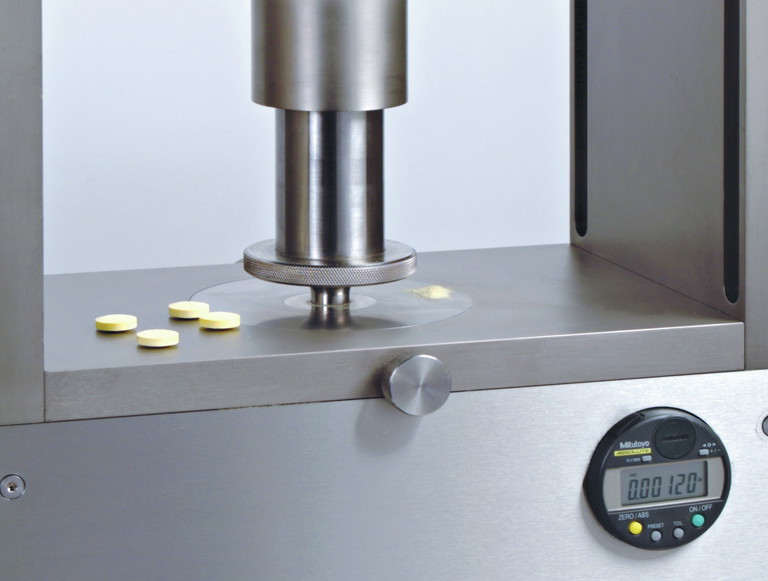SPOT LIGHT
Natoli – data collection tips for R&D presses
Tablet formulation development often uses small R&D tablet presses to optimise both the composition of the formulation and manufacturing process parameters. These types of machines have a wide variety of capabilities and may be either single station or small rotaries.

Tablet tensile strength is a key attribute as it determines whether tablets will survive ejection from a tablet press, film coating, packaging and transport. A common minimum value to be considered a robust tablet intended to be swallowed is 1.7MPa (megapascals) while chewables and orally disintegrating tablets need to be softer with a minimum of 1.0MPa. Tablet tensile strength is calculated by inputting tablet geometry (including tablet thickness) and hardness (breaking force) values that are included in some R&D press software packages, such as Natoli AIM. Please contact us if you need help calculating tensile strength.
Tablet hardness (also known as breaking force) by itself is not an accurate representation of tablet robustness since it is proportional to tablet size. In other words, a small hardness value may be just fine if it is a small tablet, but worrisome if on a large tablet.
Tabletability is the relationship between compaction pressure and tablet tensile strength. This plot is essential to understand the amount of force needed to make robust tablets. To conduct this test, you’ll run an R&D press at varying compaction forces and measure the resulting tensile strength of the tablets being produced. For tablet compression, the pressure is equal to the force applied divided by the die hole surface area (cross-sectional area of the tablet). The R&D press must, at minimum, be able to measure compaction force, so that a researcher can graph a tabletability plot.
Compressibility is the relationship between compaction pressure and porosity (or solid fraction), measuring the reduction in volume as a result of applied pressure. To conduct this test, you’ll need to know the true density of your formulation (which can be measured with a helium pycnometer). Since the porosity of the tablet is a critical factor for disintegration/dissolution times, knowing the compressibility profile of your formulation helps to identify whether your tablet can be made within the force limits of the tooling while also having good bio-availability.
Compactibility is the relationship between tablet tensile strength and porosity; this graph can be drawn from tabletability and compressibility studies. Compactibility studies help identify if you can make a tablet that can have both adequate tensile strength and enough porosity to provide bio-availability.
Tailoring porosity is crucial for achieving desired drug release profiles and overall tablet quality.
USP <1062> tablet characterisation includes tabletability, compressibility and compactibility – these plots can be generated from the data manually with a spreadsheet or automatically with data acquisition software, such as Natoli AIM Pro. Heckel plots are a more sophisticated method to look at the relationship between porosity and compaction pressure, which can be used to assess the formulation’s plasticity and identify the proper pre-compression setting among other things. Heckel plots graph the value of ln(1/(1-D)) against pressure, where D is (compressed density/formulation true density).
To get the compressed density of the tablet, you’ll first need to calculate its volume, using values for cup volume, die hole surface area and cup depth as shown in your tablet drawing (tablet volume = 2 * cup volume + die hole surface area * (tablet thickness – 2 * cup depth). Tablet compressed density is tablet weight/tablet volume.
Ejection pressure is an incredibly useful value to measure during R&D as it allows for optimisation of the amount of lubricant needed in the formulation. Radial die force measurements, if available on your R&D press, are directly proportional to ejection pressure. The goal generally is to use the minimum amount of lubricant necessary in the formulation to keep ejection pressure low enough to avoid tablet defects. Measuring die wall force or ejection force is recommended for R&D applications (ejection force monitoring is an option on all Natoli tablet presses, including the RD30).
Dwell time is the time that compaction occurs under maximum pressure, which is a critical manufacturing process parameter defined by the formula: dwell time = (punch head flat size * 60) /(RPM * Pi * PCD) where PCD is the pitch circle diameter of the press. In R&D, the press’s PCD is often small, which limits how short a dwell time can be replicated for testing. A formulation may make good tablets when there is plenty of dwell time for consolidation, but poor when run with shorter dwell times as often needed in production scale. When this is the case for a formulation, it is said to be strain rate sensitive. To identify whether your product can run in production scale and speeds, it is essential to select an R&D press that can replicate short dwell times and this requires an adequately sized PCD (bigger is better). The Natoli RD30, for example, has a 200mm PCD allowing dwell times with TSM ‘B’ domed tooling as short as 9.1 milliseconds.
Automatic weight control (AWC), along with single tablet reject, is often thought as necessary for tablet production, but the data collected with these systems in R&D can be invaluable for establishing whether your production process will be in control (have small enough variations). Each compression event in an AWC has a measured force that is collected to determine relative standard deviation %, (RSD%) – this is also known as coefficient of variation. Values over 5% RSD should not be released to production. R&D presses, such as the Natoli RD30, have AWC and can provide RSD.

Todd Martin is senior technical service engineer at Natoli Engineering. Prior to his role at Natoli, Mr Martin served as a senior tooling engineer at Wilson Tool International for over five years, and in multiple tooling-related roles for over 22 years at Thomas Engineering. Beyond authoring technical articles, Mr Martin provides troubleshooting, training and technical support. He advises and completes complex tablet and tool designs for customer products. He is also a steering committee member of the American Pharmacists Association for the Tableting Specification Manual 8th Edition that sets tablet tooling standards for North America.
Natoli Engineering is your partner in achieving manufacturing excellence. Contact us today to learn how we can support your tablet and capsule production needs. For more information, visit our website or reach out to our team of experts who are ready to assist you in optimising your manufacturing process.